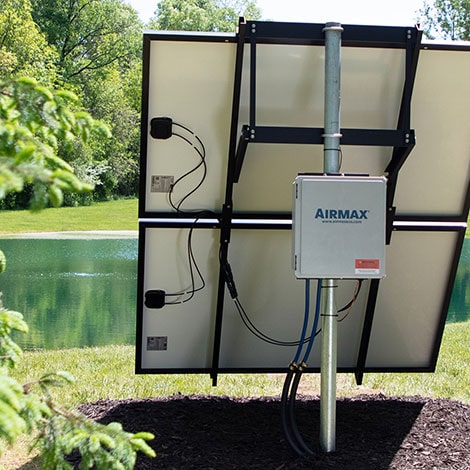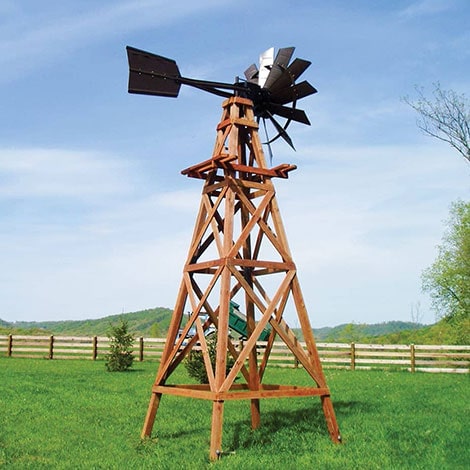Aeration is vital to maintaining a healthy and thriving pond ecosystem, but some ponds lack access to electricity. Multiple energy options are available to remote pond and lake owners, and we will explore diffused aeration systems powered by solar, wind, and electricity. Understanding each system’s unique benefits and limitations informs you which option best suits your pond’s needs.
Solar-Powered Pond Aerators
Improvements in photovoltaic technology make solar the premier option for off-grid pond aeration, wherever electricity access is limited or unavailable. A solar pond aerator converts sunlight into electricity, powering the compressor that pumps air into the pond.
When choosing a pond aerator, consider the following aspects of solar aeration:
- Reliable Off-Grid Pond Aeration: Solar is perfect for remote ponds with limited or no electricity access. Solar pond aeration can be installed virtually anywhere, provided the system receives adequate sunlight exposure. Once installed, solar aeration systems run on 100% renewable energy, resulting in zero operating costs. Solar is ideal for environmentally-conscious pond owners, remote ponds, and those requiring an alternative energy source.
- Direct Drive and Battery Backup: The two main types of solar aeration systems are direct drive and battery backup.
- Direct drive aeration systems run during daylight for up to 12 hours daily. Direct drive aeration will prevent winter fish kills in freezing climates and provide supplemental oxygen saturation during the hot summer.
- Battery-backup aeration systems feature batteries that store energy during the day and power the system at night. Airmax is the first in the industry to achieve up to 24 hours of continuous solar aeration operation.
- Aeration provides many pond benefits, including muck reduction, improved water clarity, algae control, and fish health. These benefits are optimized when pond air pumps operate 24 hours per day, so we recommend choosing battery backup whenever possible.
- Solar Panels: Quality is essential for solar panels since superior photovoltaic cells produce more energy per square inch than inferior cells in the same lighting. Systems with high-quality, American-made solar panels deliver maximum performance even in low-light conditions, like winter months and cloudy days.
- Solar Aeration Limitations: Solar pond aerators offer environmental benefits and potential long-term cost savings, but they have some limitations.
- Solar-powered aeration equipment is typically more expensive upfront than traditional wired systems. However, solar power has zero operating costs, and the average return on investment occurs between six to eight years of run time.
- A typical solar unit can pump air to a maximum depth of about 25 feet. If you have a deep pond or lake, you may be unable to place diffusers in areas of the waterbody exceeding this maximum operating depth.
- Installation is more complicated compared to electric systems. Careful positioning of solar panels is crucial to ensure optimum southern sun exposure and avoid obstructions that could block sunlight. Failure to correctly position the panels will result in decreased performance.
Wind-Powered Pond Aerators
Wind-powered pond aeration systems can be productive in specific areas with consistent and sustained high-wind patterns. Consider the following:
- Wind Naturally Aerates a Pond: Gusts moving across the water’s surface naturally provide limited aeration on windy days. Simultaneously, wind-powered aerators are operating at maximum efficiency. Winds generally decrease at night and during the hottest parts of the day, when aeration is most critical. This means wind-powered aeration systems may fail to deliver enough oxygen and water circulation to benefit the pond.
- Best as Supplemental Aeration: Wind-powered aeration is recommended only for particularly breezy locations or as a supplement to other systems. Wind power is generally not recommended as the single source of aeration because variable wind conditions provide inconsistent performance.
- Limitations of Wind Aeration: Besides performance concerns, wind-powered aeration has other limitations. It requires a high initial investment, regular maintenance, and a complicated installation process that involves erecting a windmill.
Electric-Powered Pond Aerators
Electric aeration systems are the most reliable and efficient option for many pond and lake owners. Hard-wired aeration systems powered by electricity have distinct advantages and fewer limitations:
- Reliable and Consistent: A wired pond aeration system ensures a steady oxygen supply, improving water circulation and overall quality. Consistent air pumping into the water with no downtime keeps your pond in optimal condition.
- Energy-Efficient: Advancements in compressor technology have significantly reduced electricity consumption, making electric-powered aeration systems energy-efficient and cost-effective solutions.
- Year-Round Operation: Electric diffused aeration systems can be used year-round, regardless of weather conditions. They are not dependent on unpredictable factors such as sunlight or wind gusts, ensuring consistent aeration when it is most needed.
- Models for Various Pond Sizes & Depths: Whatever the size and depth of your pond or lake, you’ll find an electric model that fits. If you’re unsure which Airmax Aeration System is right for you, let us create a free pond profile. We guarantee the results!
Pond Aerator Questions?
If you have further questions or want to learn more about which aeration system is best for your pond or lake, contact our team of pond experts online or by phone at 866-766-3435. We are here to assist you in achieving optimal aeration for a balanced ecosystem.
Explore these related aeration articles:
Why Add Aeration?
Is Your Pond Properly Aerated?
How to Aerate a Pond Without Electricity
Types of Pond and Lake Aeration Systems
Do I Need to Aerate My Pond in the Winter?
Last Updated: March 29, 2024



